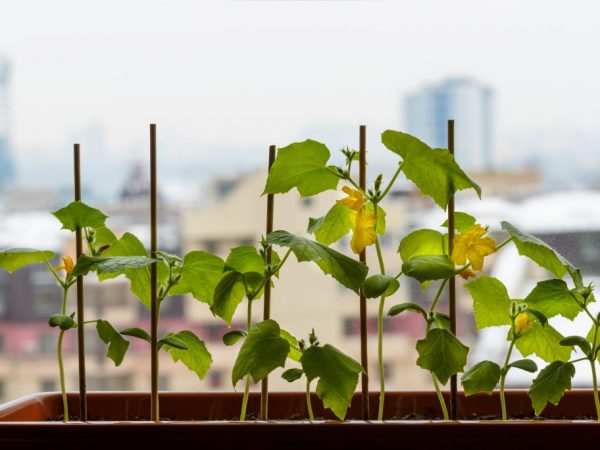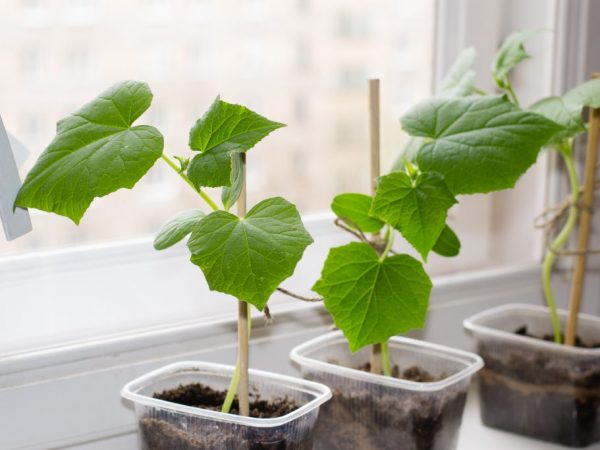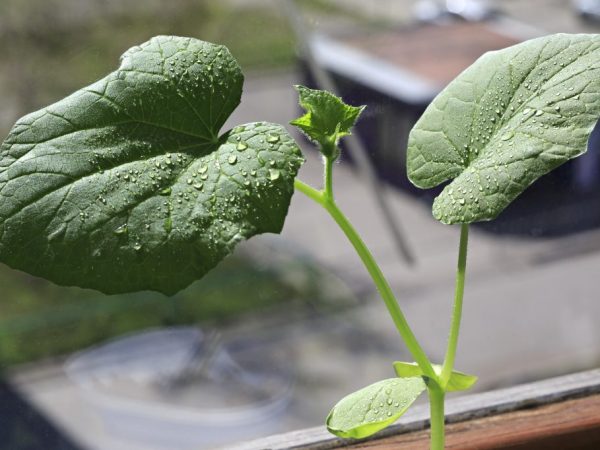Popular varieties of cucumbers for growing on the windowsill
Everyone has long been accustomed to the fact that fresh cucumber can only be bought in the store in winter. But, these vegetables are very different in taste from their garden counterparts, and they have no smell at all. Resourceful florists living in apartments have found a way to grow cucumbers on the windowsill in winter. Sorts of cucumbers for growing on the windowsill need to be selected shade-tolerant.

Popular varieties of cucumbers for growing on the windowsill
Features of culture
Today it is no longer possible to surprise anyone with apartment cucumbers. An increasing number of summer residents prefer not to part with the vegetable garden even in winter. Home Growing Benefits:
- compact plants will not take up too much space;
- you can choose a high-yielding species;
- cucumbers ripen very quickly, after 28-35 days you can eat the fruits.
However, there are varieties of cucumbers for growing on the windowsill that are not completely suitable for these purposes. Some varieties will only be able to grow in open ground or a greenhouse, and there will be too little space for them on the windowsill, so the plants will not be able to develop and bear fruit normally. To understand how to choose varieties of cucumbers for growing on the windowsill, you need to study all the existing categories.
How to choose
To grow cucumbers from seeds on the window, you need to choose the right crop. It must meet certain criteria:
- plants should not take up much space, so it is better to give preference to bush species;
- the species must be high yielding;
- choosing the best seeds, unpretentious, not demanding varieties, will be able to show themselves better in an apartment: in houses in winter it is rather dry due to centralized heating, and cucumbers love moisture, in addition, plants may experience a lack of light;
- F1 hybrids are an excellent choice for an apartment;
- it is important not to forget that only self-pollinated or parthenocapic varieties should be selected for an apartment.
Verified varieties
The best varieties of cucumbers on the windowsill in winter are presented below.
- Window-balcony F1.
- Ekaterina F1.
- Gift of the East F1.
- Zozulya F1.
- Hostess F1.
- Masha F1.
- Onega F1.
Window-balcony F1
The window-balcony view is specially designed for growing in an apartment. The flowers are predominantly feminine. The first fruits are eaten within 55 days from the date of sowing.
The crop yield is quite high: from 1 m2 it is possible to collect up to 15 fruits. The vegetables have a smooth texture. The length of the fruit can reach 16 cm. The main advantages of the variety are shade tolerance, good resistance to various diseases, as well as to possible temperature changes.
Ekaterina F1

This variety can withstand the absence of light
Cucumbers are named after the great Russian empress. The ripening period for the fruit is 50 days. The bushes are medium sized. The fruits are dark green in color, their length is 23 cm.
High-yielding species. From 1m2 it is possible to collect 18 kg of cucumbers.The hybrid variety is frost-resistant, practically not susceptible to diseases, shade-tolerant.
Oriental Gift F1
Self-pollinating hybrid. Refers to mid-season varieties. It braids poorly, making it an ideal choice for growing in winter in an apartment.
Fruits are dense, small in size, up to 10 cm. There is a light fluff on the surface of the cucumbers. Medium-yielding species. Up to 9 kg of fruit can be harvested from 1 m2. Cucumbers of this variety are considered universal: it will not be difficult to preserve them, as well as eat them raw.
Zozulya F1
Hybrid for salad purposes. It branches weakly. The yield of this variety is excellent. The first fruits appear after 45 days.
The fruit has white thorns. The structure of the skin is rough and dense. Large cucumbers up to 22 cm. Store well.
Hostess F1
The cucumbers on the windowsill of this variety are a frost-resistant hybrid. Refers to medium early varieties. Strongly branched, not limited in terms of growth. In an apartment, it is often grown in a balcony. The room must be necessarily glazed.
The fruits have a tough, lumpy structure. Perfect for preservation and raw consumption. The sizes of the fruits are small - up to 15 cm.
Masha F1
Does not require pollination. Refers to parthenocapic varieties. The fruits can be harvested after 45 days.
High-yielding variety. The plant is not susceptible to diseases. Fruits without bitterness. It is considered a versatile vegetable suitable for eating raw and pickling.
Onezhsky F1
An early ripening hybrid. The first fruits appear after 38 days. The plant is self-pollinated. With the majority of female flowers.
The bush branches weakly, with a fixed growth point. Fruits are striped with a black downy. Refers to the universal varieties.
Growing

Compliance with the rules will help you get the desired harvest
To successfully grow cucumbers at home, you need to follow some rules, just like when growing outdoors. First you need to prepare the container. It is better to take an oblong capacity at the rate of 5 liters per 1 bush. Drainage holes should be made in the bottom. After that, you can start preparing the soil mixture.
Cucumbers love fertile soil. Plus, you need to take into account that in a small pot, plants will very quickly draw out all the nutrients from the soil. The best option would be a mixture of sand, fertile soil, peat or humus, sawdust and ash. To disinfect the soil, it should be calcined in the oven, and only then used for planting.
About a day before planting the seeds, the soil is poured into pots and watered abundantly with settled water. Seeds can be planted the next day. Previously, the seeds must also be disinfected by soaking in a manganese solution. After that, the pots should be covered with foil and placed in the warmest room, you can even over the radiator. When shoots appear, the cellophane should be removed.
As the bushes grow, they will need to be shaped. At the beginning, only the top is pinched so that only the lateral branches grow, then they will also need to be pinched. Pinching the lashes begins above 10 sheets. The scourge must be tied up so that the plant can receive enough light.
Care
It will be possible to successfully grow cucumbers in an apartment or a balcony only if all the rules for caring for plants are followed. There are varieties that tolerate shade normally, but you should still choose the most illuminated part of the balcony or room. In addition, additional lighting is needed on cloudy days.
Organic matter should be added periodically. An excellent fertilizer is an infusion of fermented banana skins. Watering should be done quite often, because cucumbers are moisture-loving plants and the juiciness of the fruits will depend on this. After each watering, you need to gently loosen the soil to improve soil aeration.
In dry conditions, cucumbers will become bitter.If the rooms are too dry, plants should be sprayed with water and placed next to a container of water. When the plants begin to bear fruit, harvest them regularly. So it will be possible to extend the period of fruiting.
Conclusion
Many types of cucumbers are suitable for winter cultivation in an apartment. F1 hybrids are an excellent option. Many farmers only use them. To grow cucumbers in an apartment, you need to take into account several nuances. It is necessary to select species that are shade-tolerant and, most importantly, self-pollinated. Unlike parthenocapic species, self-pollinated species can be grown from seeds in the future.
If artificial illumination can be organized, then there is no way to get live bees in the apartment. For planting, you need a fairly large container, at the rate of 5 liters per 1 plant. Cucumbers should be placed in the lightest room.
In the darkest months (January and February), plants need to be artificially illuminated so that they can synthesize chlorophylls normally. The advantage of this growing method is the constant availability of fresh vegetables in winter. In addition, unlike the standard planting method, cucumbers in the apartment are not attacked by pests and practically do not get sick.


